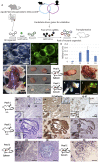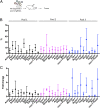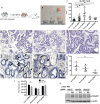CRISPR-Cas9-mediated gene knockout in intestinal tumor organoids provides functional validation for colorectal cancer driver genes
- PMID: 31300537
- PMCID: PMC6681705
- DOI: 10.1073/pnas.1904714116
CRISPR-Cas9-mediated gene knockout in intestinal tumor organoids provides functional validation for colorectal cancer driver genes
Abstract
Colorectal cancer (CRC) is the third leading cause of cancer-related deaths worldwide. Several genome sequencing studies have provided comprehensive CRC genomic datasets. Likewise, in our previous study, we performed genome-wide Sleeping Beauty transposon-based mutagenesis screening in mice and provided comprehensive datasets of candidate CRC driver genes. However, functional validation for most candidate CRC driver genes, which were commonly identified from both human and mice, has not been performed. Here, we describe a platform for functionally validating CRC driver genes that utilizes CRISPR-Cas9 in mouse intestinal tumor organoids and human CRC-derived organoids in xenograft mouse models. We used genetically defined benign tumor-derived organoids carrying 2 frequent gene mutations (Apc and Kras mutations), which act in the early stage of CRC development, so that we could clearly evaluate the tumorigenic ability of the mutation in a single gene. These studies showed that Acvr1b, Acvr2a, and Arid2 could function as tumor suppressor genes (TSGs) in CRC and uncovered a role for Trp53 in tumor metastasis. We also showed that co-occurrent mutations in receptors for activin and transforming growth factor-β (TGF-β) synergistically promote tumorigenesis, and shed light on the role of activin receptors in CRC. This experimental system can also be applied to mouse intestinal organoids carrying other sensitizing mutations as well as organoids derived from other organs, which could further contribute to identification of novel cancer driver genes and new drug targets.
Keywords: CRISPR-Cas9; activin; colorectal cancer; driver gene; organoid.
Conflict of interest statement
The authors declare no conflict of interest.
Figures






Similar articles
-
Transposon mutagenesis identifies candidate genes that cooperate with loss of transforming growth factor-beta signaling in mouse intestinal neoplasms.Int J Cancer. 2017 Feb 15;140(4):853-863. doi: 10.1002/ijc.30491. Epub 2016 Nov 7. Int J Cancer. 2017. PMID: 27790711 Free PMC article.
-
A Platform for Validating Colorectal Cancer Driver Genes Using Mouse Organoids.Front Genet. 2021 Jun 28;12:698771. doi: 10.3389/fgene.2021.698771. eCollection 2021. Front Genet. 2021. PMID: 34262603 Free PMC article. Review.
-
Organoid modelling identifies that DACH1 functions as a tumour promoter in colorectal cancer by modulating BMP signalling.EBioMedicine. 2020 Jun;56:102800. doi: 10.1016/j.ebiom.2020.102800. Epub 2020 Jun 6. EBioMedicine. 2020. PMID: 32512510 Free PMC article.
-
An In Vivo Metastasis Model Using Genotype-Defined Tumor Organoids.Methods Mol Biol. 2024;2828:57-68. doi: 10.1007/978-1-0716-4023-4_6. Methods Mol Biol. 2024. PMID: 39147970
-
CRISPR/Cas9: a powerful tool in colorectal cancer research.J Exp Clin Cancer Res. 2023 Nov 22;42(1):308. doi: 10.1186/s13046-023-02901-z. J Exp Clin Cancer Res. 2023. PMID: 37993945 Free PMC article. Review.
Cited by
-
Current concepts in tumour-derived organoids.Br J Cancer. 2020 Oct;123(8):1209-1218. doi: 10.1038/s41416-020-0993-5. Epub 2020 Jul 30. Br J Cancer. 2020. PMID: 32728094 Free PMC article. Review.
-
Expression Signature of the AT-Rich Interactive Domain Gene Family Identified in Digestive Cancer.Front Med (Lausanne). 2022 Jan 20;8:775357. doi: 10.3389/fmed.2021.775357. eCollection 2021. Front Med (Lausanne). 2022. PMID: 35127746 Free PMC article.
-
A Combination of Microarray-Based Profiling and Biocomputational Analysis Identified miR331-3p and hsa-let-7d-5p as Potential Biomarkers of Ulcerative Colitis Progression to Colorectal Cancer.Int J Mol Sci. 2024 May 23;25(11):5699. doi: 10.3390/ijms25115699. Int J Mol Sci. 2024. PMID: 38891888 Free PMC article.
-
Organotypic Modeling of the Tumor Landscape.Front Cell Dev Biol. 2020 Nov 24;8:606039. doi: 10.3389/fcell.2020.606039. eCollection 2020. Front Cell Dev Biol. 2020. PMID: 33330508 Free PMC article. Review.
-
A genome-scale CRISPR screen reveals factors regulating Wnt-dependent renewal of mouse gastric epithelial cells.Proc Natl Acad Sci U S A. 2021 Jan 26;118(4):e2016806118. doi: 10.1073/pnas.2016806118. Proc Natl Acad Sci U S A. 2021. PMID: 33479180 Free PMC article.
References
-
- Kinzler K. W., Vogelstein B., Lessons from hereditary colorectal cancer. Cell 87, 159–170 (1996). - PubMed
-
- Pinto D., Clevers H., Wnt, stem cells and cancer in the intestine. Biol. Cell 97, 185–196 (2005). - PubMed
-
- Bos J. L., ras oncogenes in human cancer: A review. Cancer Res. 49, 4682–4689 (1989). - PubMed
-
- Baker S. J., et al. , p53 gene mutations occur in combination with 17p allelic deletions as late events in colorectal tumorigenesis. Cancer Res. 50, 7717–7722 (1990). - PubMed
Publication types
MeSH terms
Substances
LinkOut - more resources
Full Text Sources
Other Literature Sources
Medical
Molecular Biology Databases
Research Materials
Miscellaneous

